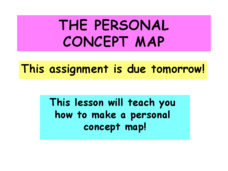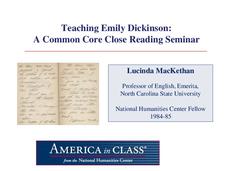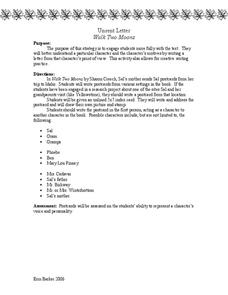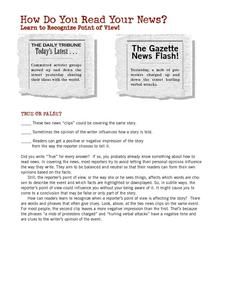C-SPAN
Presidential Birth Requirement
Every president of the United States must be a natural-born citizen, but the definition of natural-born is not as straightforward as it seems. Secondary scholars examine two points of view surrounding the constitutional requirement...
Roald Dahl
The Twits - The Furniture Goes Up
Work gets done faster when people work as a team. The ninth installment of an 11-lesson unit designed to accompany The Twits by Roald Dahl combines character education with research skills and creative writing activities. The lesson ends...
Curated OER
Photographic Memories
Explore how photographs can represent a whole story to a viewer. Middle schoolers work on narrative writing techniques in this lesson plan, focusing on photographs from the New York Times to write first-person descriptive...
Curated OER
Identify Narrative Perspective 3
In this point of view worksheet, students read passages and then write the narrator's point of view and how they know it is such. Students do this for 6 passages.
Curated OER
The Personal Concept Map
There are lots of details that make you who you are! Illustrate what those details are with a personal concept map project. After learners view a step-by-step presentation, the follow a rubric to complete a concept map about themselves.
Missouri Department of Elementary
The Clique
Mean girls and bully packs are favorite topic for films and TV shows that focus on the destructive power of cliques. High school freshmen are asked to reflect on both the positive and negative aspects of cliques by reading a short...
Curated OER
Pronouns and Perspective
In this pronouns and perspectives activity, students underline all pronouns in short passages and tell whether they are written in 1st, 2nd or 3rd person.
Book Units Teacher
Story Elements
This 97-slide PowerPoint uses Charles Dickens's A Christmas Carol, Wilson Rawls, Where the Red Fern Grows, and Jeanne DuPrau's The City of Ember, to illustrate the elements of a story. Setting, plot, characterization...
Teaching Tolerance
Using Photographs to Teach Social Justice | Confronting Unjust Practices
A powerful photograph of the Freedom Riders of 1961 launches an examination of the de jure and de facto injustices that the civil rights movement of the 1950s and 1960s addressed. Young historians first watch a video and read the Supreme...
National Endowment for the Humanities
Narrative Voice in Moby Dick
Call him a reliable narrator! Ishmael is the focus of a lesson plan that asks readers to analyze the complex character of Herman Melville's narrator as he is introduced in the first chapter of Moby Dick.
Curated OER
Identify Narrative Perspective
In this narrative perspective worksheet, learners read passages and determine point of view: first, second, third person objective/limited/omniscient.
Curated OER
Camera Movement
Students focus on different ways director and cinematographers use the camera to convey meaning, setting, tone, point of view, personal style, as well as telling a story.
Curated OER
Step into the Painting: Social Studies, Literature, and Art
Travel back in American history to the era of slavery and abolition. After reading about the Underground Railroad, young historians examine a painting depicting the event, and write a narrative from the point of view of a person in the...
Curated OER
Where the Red Fern Grows Chapter 1 Worksheet
Break down Where the Red Fern Grows by Wilson Rawls into manageable chunks by focusing on plot points and literary elements in specific chapters. This resource is all about the first chapter, and asks pupils to use complete sentences to...
Curated OER
"Tomorrow and Tomorrow and Tomorrow"
Do you want to live forever? After reading Kurt Vonnegut’s short story, “Tomorrow and Tomorrow and Tomorrow,” class groups adopt the roles of an ethics committee, product manufacturers, concerned scientists, and potential users of an...
University of the Desert
How Do I Feel That My Culture Is Misunderstood by Others?
Using video clips of young adults from around the world describing their cultures and how they can be misunderstood, learners compare their own cultural point of view to that of others through discussion and writing.
National Humanities Center
Teaching Emily Dickinson: A Common Core Close Reading Seminar
Three of Emily Dickinson's poems, "I like to see it," "Because I could not stop for Death," and "We grow accustomed to the Dark," provide instructors with an opportunity to model for class members how to use close reading strategies to...
Novelinks
Walk Two Moons: Unsent Letter
Take a journey with your class as they explore the different settings from Walk Two Moons by Sharon Creech. Middle schoolers write postcards in first person as if they were the characters of the story.
Described and Captioned Media Program
Malcolm X: Make It Plain, Part II
Track the transformation of Malcolm Little into Malcolm X and then into El Jajj Malik El-Shabazz with the second part of Make it Plain, a documentary on the famous civil rights activist. Viewers consider not only how events shaped and...
Curated OER
Tools of the Historian: Frame of Reference
Students discuss the term point of reference and describe their own point of view. They compare the relationship between sources and the historical context. They identify examples of how point of reference can affect one's interpretation.
Curated OER
Writing in First Person about the Atlantic Slave Trade Lesson Plan
Students investigate the Atlantic slave trade. In this slavery lesson, students watch "Slavery, Society, and Apartheid," as well as "Slave Ship." Students discuss the information presented in the videos, especially St. John's Revolt....
TV411
How Do You Read Your News?
Words carry baggage. Class members are asked to consider the weight of words in an exercise that contrasts the word choices in two versions of the same event. Consider following the exercise with an activity in which pairs craft positive...
Poetry Society
Writing a Personification List Poem
After a close reading of Sylvia Plath's "Mirror" and Flora de Falbe's "Five Things About the Lake," young poets craft their own personification list poem about a very special place.
Curated OER
Debate: How Should African Americans Achieve Equality?
Each group is assigned a character to play in a mock debate. They read the provided materials, build an argument, and then debate their points of view as their perspective character. The debate focuses on ensuring equality for...

























